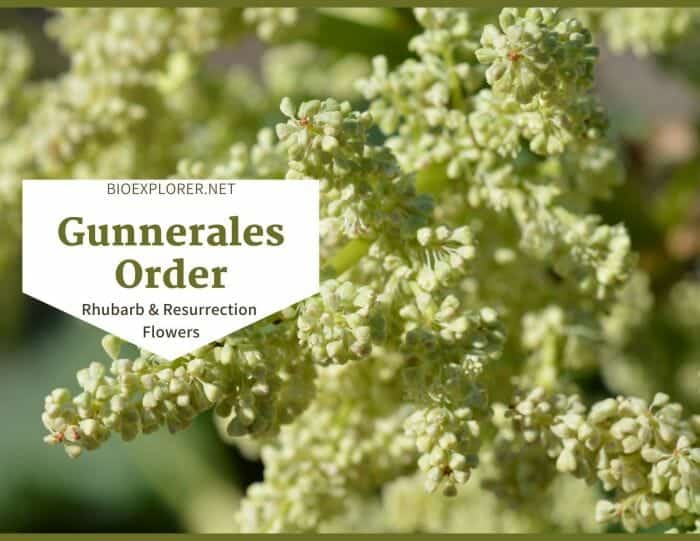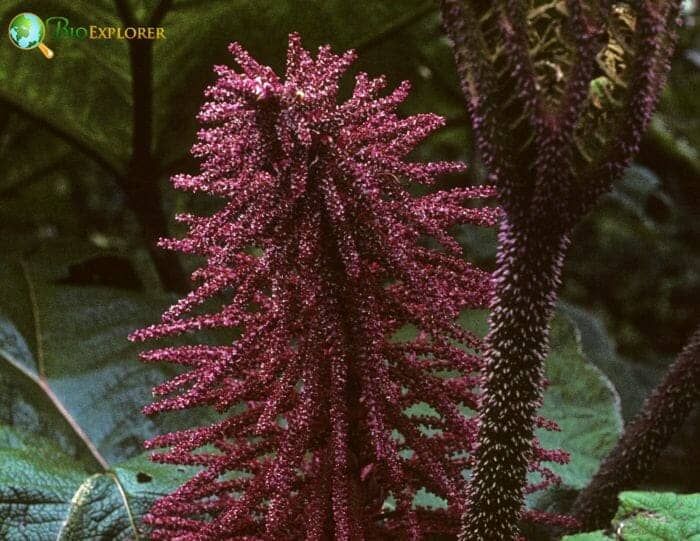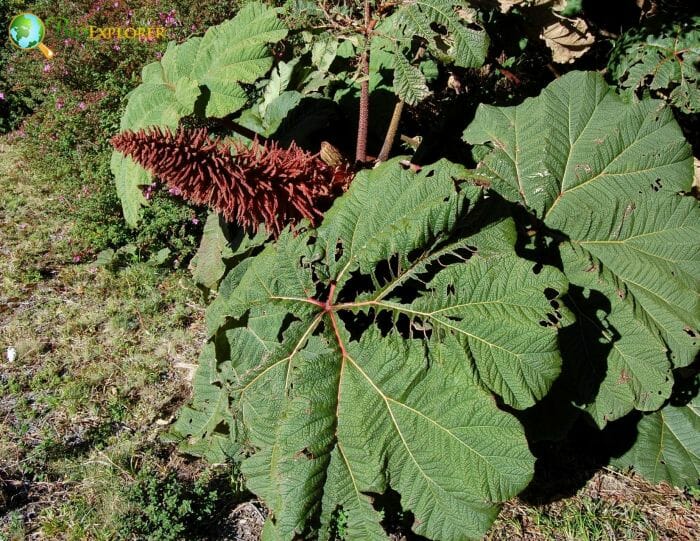
Gunnerales is an order of dicotyledonous flowers with members with ellagic acids, abundant plastids in their phloem cells, hydathodal teeth in the lamina margins of the leaf, and small flowers.
The Gunnerales plants are dioeciousWhat is dioecious?Pertaining to plants, individuals of which bear either staminate or pistillate flowers, but not both. and generally pollinated via wind. Most Gunneraceae species are found in the tropical regions above the equator, while Myrothamnaceae are endemic to Madagascar and Africa. In addition, the giant rhubarb and the resurrection plants are found under the Gunnerales order.
Table of Contents
Gunnerales Families

Gunnerales have 2 families, 2 genera, and 42-52 species[1]. The two families are so different in appearance that grouping them was a surprise. But despite the distinct dissimilarities of the size and the habitat of the two families, they manifest the same anatomy down to very small details under the electron microscope and DNA analysis.
- Gunneraceae (Giant rhubarb)
- Myrothamnaceae (Resurrection plants)
![]()
Gunnerales Distribution

The members of Gunneraceae (1 genus and 40-50 species) are usually huge herbs living in humid surroundings. Thirty-eight species of Gunnera[2] are in the Neotropics. The species of Gunnera are found in countries like Bolivia, Brazil, Central America, and Mexico. They are also present in Colombia, Ecuador, Peru, Argentina, Chile, and Venezuela.
The 2 species of Myrothamnaceae (1 genus and 2 species each[3] ) are xerophytes (plants adapted to dry habitat). Myrothamnaceae members are distributed in Africa and Madagascar.
![]()
Gunnerales Characteristics

- Plant type: Members are perennial herbs or dioecious shrubs. The two families under this order both have ellagic acid. The Gunnerales do not have the mitochondrial gene rps2 and benzylisoquinoline alkaloids.
- Stem: Their phloem cells have abundant plastids. Most species have stout and pachycaulous stems.
- Leaves: The lamina margins of the leaf contain hydathodal teeth. The secondary veins of the plants are palmate.
- Flowers and Inflorescences: The plants are dioecious, and the flowers are small. The flowers are in panicles or catkin-like inflorescences.
- Sepals and Petals: The flowers do not have much perianth. The Gunnerales members have 2 sepals and 2 petals. Other species lack petals while others completely lack the perianth.
- Stamens and ovary: The stamens are generally 2, and the carpels are 2-3.
- Ovary and Fruit: The Gunnerales plants have an inferior ovary. The fruit is a berry or a capsule.
- Seeds: The seeds are endospermic.

![]()
Gunnerales Flowers and Reproduction

Members of Gunnerales have small flowers. Both Gunneraceae and Myrothamnaceae don’t have much perianth in their flowers, even though some kind of perianth may be present in this order as being in a pleisiomorphic state(ancestral character state).
- The Gunnera plants have relatively large and brownish panicles bearing many tiny red-brown flowers. The small flowers of Gunneraceae have 2 sepals, 2 petals, 2 stamens, and 2 carpels (dimerous)[4]. The petal primordia in G. dentataemerges after the sepals, but they remain reduced.
- The petals are absent in G. macrophylla. Two petal primordia in G. monoicastart to emerge at an early stage. Still, they terminate during the early development of the flower. The species G. herteri completely lacks perianth. Members of Gunneraceae have an inferior ovary. Species are pollinated via wind. The fruits of the members are small, red, and berry-like.
- The male and female reproductive organs of Myrothamnaceae[5] are on separate individuals (dioecious). This family’s tiny flowers usually occur on short lateral branches in catkin-like inflorescences that bloom from September to November. There are 3-6 stamens with reddish anthers.
- At maturity, the anthers produce an ample amount of tricolpate pollen grains. The female flowers are zygomorphicWhat is zygomorphic?A characteristic of the flower having only one plane of symmetry, as in a pea or snapdragon; bilaterally symmetrical; especially in reference to a flower or corolla; Opposite is Actinomorphic; irregular flower;, comprising 3 carpels that are basally attached. The fruits of Myrothamnaceae are three-lobed capsules; dehiscent. Ressurection plant generally undergoes wind pollination.
![]()
Gunnerales Family Differences

Gunneraceae

- Members are perennial herbs. The plants prefer humid habitats.
- The stems are stout and pachycaulous (not markedly diminished in thickness). The leaves surround the stem. Some species of this family possess huge leaves.
- The plants have well-developed hydathodes.
- Gunneraceae are in an endosymbiotic relationship with the genus Nostoc cyanobacteria. They host cyanobacteria on the specialized organ on their stem. The leaf-like scales cover these organs.
- The flowers of the species are small, simple, and dimerous.
- The fruit is drupaceous.
![]()
Myrothamnaceae

- Members are glabrous, aromatic, and dioecious shrubs. They are xerophytes.
- The leaves are small, sessile, opposite, and can survive intense dehydration.
- The plants have poorly-developed hydathodes.
- The flowers are tiny, hypogynous, and sessile. The tepals consist of 0-4 or more present in catkin-like inflorescences.
- The pollen of the members is dispersed as tetrads.
- The fruit is a capsule with numerous seeds.
![]()
Gunnerales Example Species

The members of order Gunnerales are beneficial. The following are the example species under this order:
- Chilean rhubarb[6] is a trendy ornamental plant in gardens and parks. The stalks are edible.
- Dinosaur food[7] – The plant is used for gardens and landscaping.
- Devil’s strawberry[8] – The species is an ornamental plant used as a groundcover or planted in the garden.
- Groundcover gunnera[9] – This species can be used as ground cover, but it can spread undesirably (invasive).
- Poor man’s umbrella[10] – The plant has ornamental value because of its huge leaves and pretty red veins.
- Creeping rhubarb[11] is used as a groundcover and a garden plant.
- Wild rhubarb[12] – The plant has many medicinal uses. The petioles and the flowers stalks can be eaten raw.
- Resurrection plant – The plant is essential in Africa because of its medicinal value.
- Myrothamnus moschata
- Gunnera bogotana
![]()
















